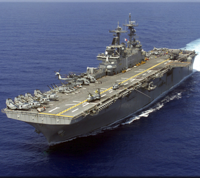Over the past two weeks, the U.S. Navy and Marine Corps conducted Bold Alligator, an exercise off the Atlantic seaboard designed to refine expertise in amphibious operations and test new amphibious capabilities. The exercise included the USS Enterprise supercarrier, three amphibious assault vessels -- the USS Wasp, the USS Kearsarge and the USS Iwo Jima -- as well as a bevy of support vessels. Nine international partners joined Bold Alligator in some fashion, including Australia, Canada, France, Germany, Italy, the Netherlands, New Zealand, Spain and the United Kingdom, with the French LPD Mistral representing the most significant allied commitment. The exercise demonstrated, to both domestic and international audiences, the continued importance of amphibious capabilities within the U.S. policy “toolbox,” while also providing an opportunity to refine and extend those capabilities.
While Bold Alligator, or something like it, would probably have taken place under any budgetary context, the exercise represented a reaffirmation of the Navy’s commitment to amphibious operations at a time of tightening budgets. From a budgetary standpoint, amphibious warfare also benefits enormously from the advocacy of the Marine Corps, which continues to view amphibious warfare as a core capability. Bold Alligator simulated a high-intensity combat landing into terrain controlled by insurgents fighting a friendly government, and involved both sea and air elements. The basic necessities for such operations, however, also apply to amphibious relief missions of the sort conducted in Southeast Asia after the 2004 tsunami, or Haiti after the 2010 earthquake. While relief operations might be a harder sell in Congress than “hard” military capabilities, they tend to happen more often than forced-entry amphibious assaults and have substantial political effect, at least on a regional scale. Combining the two concepts and working on both simultaneously allows the Defense Department to develop relief expertise while maintaining a hard combat edge.
Internet and data capabilities may seem secondary to major amphibious operations. However, most amphibious operations in the future will be rich in political context, whether they involve forced entry or not, and the ability to manage data and the political environment represents an absolutely critical capability for modern amphibious warfare. Consequently, information technology played a major role in this exercise. Coordination between a large number of warships and international partners requires the sharing of a tremendous amount of data between widely separated units a “network-centric warfare” concept that applies to both high-intensity combat and low-intensity relief operations. Consequently, Bold Alligator provided an opportunity to test the latest in military communications technology.

